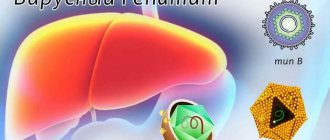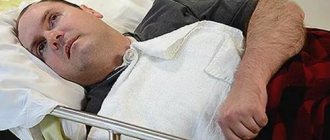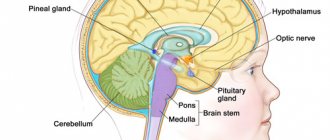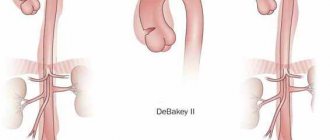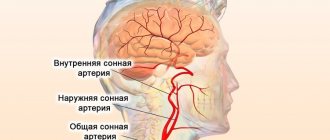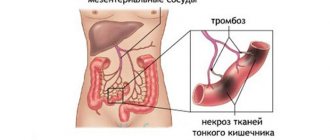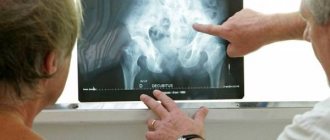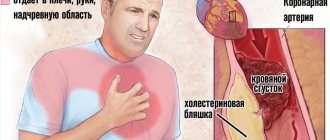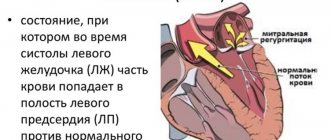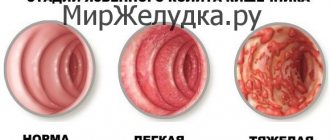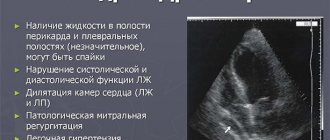Spinal stroke is an acute disruption of the blood supply to the spinal cord. By analogy with a cerebral stroke, this pathology is also called a spinal cord stroke or even a spinal stroke.
Are these names correct? Yes. Because all three arteries (artery of Adamkiewicz, artery of Lazort and artery of Deproge-Gotteron) supplying blood to the spinal cord can be damaged. Depletion of cell nutrition or its complete cessation leads to the same necrosis of spinal cord cells as in the case of brain cells.
The result is loss of sensitivity in many areas, movement disorders, and dysfunction of the pelvic organs.
Both men and women are at risk. Moreover, starting from working age - from thirty years.
For reference. Of course, a spinal stroke is less dangerous than diseases associated with the brain, however, in some cases it leads to disability and even death.
Diagnosis of the pathology is quite difficult due to its similarity with polio and some types of multiple sclerosis. The disease develops in stages.
Why does it occur
Problems not only with the spinal column, but also with the blood vessels that feed it can provoke the development of pathology. There are many causative factors, divided into several main groups.
Spinal stroke
Primary lesions of blood vessels that occur against the background of diseases of the vessels themselves:
- myocardial infarction, atherosclerosis, hypertension and other general somatic pathologies;
- systemic vasculitis;
- development of thrombosis, embolism, varicose veins and other vascular diseases.
Blood supply to the spinal cord
Secondary vascular lesions associated with external processes:
- development of pathologies of the spinal membranes, such as leptopachymeningitis and arachnoiditis;
- malignant and benign formations;
- diseases of the spinal column (lordosis, hernia, osteochondrosis, etc.).
Lordosis - what is it?
Additional factors that provoke spinal stroke:
- blood diseases;
- development of inflammatory processes;
- disturbances in the functioning of the endocrine system;
- carrying out diagnostic measures on the spine;
- mechanical injuries to the back resulting from injury or surgery.
Ischemic spinal cord stroke
Note! When several precipitating factors are combined, the risk of stroke increases. Such factors also include alcohol abuse, overheating of the body, increased load on the spine and physical overexertion (especially when playing strength sports).
Features of blood supply to the spinal cord
The spinal cord is supplied by branches of the vertebral, cervical, intercostal, sacral, lumbar arteries and the aorta.
Two posterior and one anterior spinal artery emerge from the vessels of the vertebral-subclavian and aortic basin. The posterior ones run along the dorsal roots of the nerve processes. The front one fits into the longitudinal slot. All three vessels extend to the end of the spinal cord.
The vertebral-subclavian branches adjoin the cervical and partly the thoracic region, the branches of the aorta adjoin other parts of the spinal cord.
Inside the spinal column, all vessels are connected by anastomoses.
Characteristic symptoms
Depending on the location of the lesion, the signs of a spinal stroke may vary. As a rule, before a pronounced clinical picture appears, the patient encounters symptoms that are precursors of a stroke (pain in the back and lower extremities, intermittent lameness in the legs).
Difficulties in diagnosing spinal cord stroke
In the absence of timely diagnosis and treatment, a spinal cord stroke occurs. Common signs of this disease include:
- decreased sensitivity of the skin in the back area;
- pain syndrome;
- disruption of the pelvic organs, which are expressed in the form of fecal incontinence;
- general weakness of the body;
- occasional lameness;
- paralysis of the legs and decreased sensitivity of muscle tissue (the patient stops responding to increased temperature, various injuries, etc.).
Main symptoms of stroke
There are a number of symptom complexes that are combined into syndromes. They allow doctors to find where spinal strokes occur and identify affected blood vessels. These symptom complexes include the following syndromes:
- amyotrophic lateral sclerosis;
- Brown-Sequard;
- centromedullary ischemia;
- arterial ischemia;
- Preobrazhensky;
- anterior ischemic poliomyelopathy.
The first signs of a stroke
All of the above syndromes share common symptoms, and if they appear, you should seek help from a doctor as soon as possible.
Diagnostics
Diagnosis begins with a detailed history.
It is important what the nature of the onset was and in what sequence the symptoms developed. The abnormalities discovered during the examination suggest the localization of the overall pathological focus.
But individual variations in the spinal blood supply are too diverse, and this makes it difficult to determine a clear location of the vascular rupture. In this regard, the following series of necessary studies are used in diagnosis:
CT or MRI of the spine to determine damage or displacement of the vertebrae, the presence/absence of osteophytes or fragments, whether the intervertebral space is narrowed or not. The visual method helps to detect compression of the spinal canal, spinal tumors, hematomas or herniated discs
- Angiography to detect malformations, aneurysms, vascular compression and thrombosis;
- General blood test and sugar test;
- Ultrasound using Doppler ultrasound;
- Spinal cord puncture;
- Electroneuromyography helps to detect innervation disorders in individual muscles.
First aid
If there is the slightest suspicion of the development of a spinal stroke, then the first thing to do is call an ambulance. But before the doctors arrive, the patient must be given first aid. To do this, place the patient on his back, preferably on a hard surface. All further transportation must take place in this position.
What to do before the doctors arrive
On a note! An incorrect diagnosis or untimely treatment of a stroke can lead to the patient’s loss of ability to work or even disability. Therefore, timely diagnosis is so important.
First aid for spinal stroke
Diagnostic methods
Making a correct diagnosis is difficult, since any spinal cord lesion gives similar clinical signs, determined by the location of the pathological process. A stroke resembles polio or cerebellar dysfunction, a spinal variant of multiple sclerosis. Therefore, you need to pay attention to the very first symptoms of the disease, as well as the speed of their increase.
Based on typical symptom complexes, the level of tissue destruction can be determined.
The following methods are used for confirmation:
- Angiography helps identify a vessel that is blocked or destroyed.
- MRI and CT reveal the localization of the source of hemorrhage or ischemia.
- Myelography with spondylography helps visualize the structure of the spine and spinal cord tissue. Prescribed if there is a preliminary suspicion of a tumor, hernia, or injury to the arteries by parts of the vertebrae.
- Electrophysiological diagnostics determine muscle strength, innervation and impairment.
Diagnostic features
After the patient is admitted to the hospital, he undergoes a neurological examination to check hemodynamics, that is, to study the movement of blood through the affected vessels. After a detailed examination, the doctor may prescribe additional laboratory tests, including:
- coagulogram (blood test for clotting);
- blood test for electrolytes;
- biochemical analysis for proteins, cholesterol, lipids and sugar levels;
- measurement of erythrocyte sedimentation rate (ESR);
- general blood analysis.
General blood test table
As a supplement, the patient is prescribed instrumental diagnostic methods, the most effective of which include:
- X-ray examination;
- electrocardiography;
- ultrasound duplex scanning of the brachiocephalic arteries;
- CT and MRI;
- vascular angiography.
Based on the results of the tests and procedures performed, the doctor will be able to make an accurate diagnosis and prescribe an appropriate course of therapy. The sooner treatment is started, the greater the chances of a successful and rapid recovery.
MRI in angiography mode
Symptoms
Symptoms of stroke are very diverse and depend not only on the cause of the disease, but also on the location of the affected vessel. Before the appearance of characteristic symptoms, the first precursors of the disease are observed:
- weakness in the legs, intermittent claudication;
- numbness in the back;
- awkwardness of movements.
If these signs of an impending disease are ignored, the next stage of damage occurs - the stroke itself.
There are general symptoms of the process, regardless of its type:
- loss of sensitivity, goosebumps;
- paresis of the lower extremities;
- muscle weakness;
- severe back pain;
- convulsive twitching.
If blood flow in the sacrococcygeal segment is impaired, paralysis is not observed, but patients lose the ability to control bowel movements and urination.
Treatment methods
There are several treatment methods used to diagnose a spinal stroke. The most effective are drug therapy, the use of physiotherapy and surgery. Let's consider each of these methods separately.
Treatment of spinal stroke
Pharmacy drugs
Immediately upon arrival, doctors give the patient some medications. First of all, these are diuretics designed to eliminate or reduce tissue swelling. Such drugs include Lasix and Furosemide. The optimal dosage is from 80 ml per injection. Then, in a hospital setting, the patient is prescribed drugs to improve metabolic processes and blood circulation in the back area (Metamax, Mildronate, Actovegin, etc.).
"Actovegin"
To restore damaged nerve tissue, Vinpocetine and Cerebrolysin are used for spinal stroke. The dosage and duration of the therapeutic course is determined by the doctor. This is done taking into account the patient’s age and general condition. Anticoagulants are used to reduce the risk of blood clots and activate the blood thinning process. But Fraxiparin, Heparin and other drugs from the anticoagulant group can be used only when diagnosing an ischemic spinal stroke. In case of hemorrhagic disease, it is prohibited to take such drugs.
"Heparin"
The above potent drugs can be supplemented with biogenic stimulants and muscle relaxants, for example, Baclofen or Mydocalm. If there are serious complications, the doctor may increase the dosage or, conversely, reduce it if the severity of the symptoms of the pathology decreases.
"Mydocalm"
Physiotherapy
To enhance the therapeutic effect, physiotherapeutic procedures can be used together with drug treatment. Below are the most common ones.
Physiotherapy for spinal stroke
Table. Physiotherapy for spinal stroke.
| Procedure name | Description |
| Diathermy | A method of applying high-intensity electric current to affected tissue. A special device is used for this. Diathermy allows you to accelerate regenerative processes in the patient’s body. |
| Electrophoresis | The essence of this method is to introduce the drug into the body through the skin by applying an electric current. The procedure cannot be called pleasant, but it is very effective. |
| Acupuncture | Since ancient times, traditional Chinese medicine has used acupuncture - a therapeutic effect on the body with special needles. They were pierced into the patient’s body through special points, due to which a therapeutic effect was achieved. |
| Massage | Regular massage sessions improve metabolism in the affected area, thereby accelerating the healing process. But the maximum therapeutic effect can be achieved only if the massage is performed by a qualified specialist. |
| Exercise therapy | Therapeutic gymnastics is prescribed in cases where the disease does not hinder the patient’s movements. Initially, light exercises are performed, and over time the intensity of the training increases. |
Note! If symptoms worsen, doctors may prescribe wearing a special orthopedic corset. This will alleviate the patient’s condition and relieve pain. When choosing a corset, you must take into account all the recommendations of your doctor.
Surgery
If conservative treatment methods are ineffective, the patient may be prescribed surgery. As a rule, surgery is performed when a hemorrhagic stroke is diagnosed. In this case, the surgeon sutures the blood vessels, thereby restoring their patency. If there is such a need, the underlying pathology that provoked impaired blood circulation can be treated surgically.
Surgery
Treatment of spinal stroke
After clarifying the diagnosis, treatment tactics are determined. It includes drug therapy and surgery.
To normalize blood viscosity in the case of ischemic stroke, drugs aimed at reducing it are used: Heparin, Aspirin. In case of hemorrhagic stroke - to increase it. Hemostatic agents include Gordox and Dicynon.
Medicines are prescribed to improve blood circulation and metabolism in the central nervous system. These are Cavinton, Nitsergolin, Enelbin.
In order to improve venous blood flow, it is recommended to use Aescusan, Troxevasin.
Protection of neurons from damage is provided by Actovegin, Nootropil, Tanakan. You can improve the passage of nerve impulses with Neuromidin.
To improve the condition of blood vessels, ensure their functions, and correct microcirculation, angioprotectors are prescribed. This is Ascorutin, Troxerutin.
Diuretics help reduce swelling and remove excess fluid from the body: Lasix, Hypothiazide, Vreoshpiron, Furosemide.
Baclofen, Mydocalm, Trental, Agapurin help reduce muscle tone and relieve spasms.
Vitamin therapy is used. B vitamins are prescribed, for example, the drug Milgamma.
If necessary, drug blockades and immobilization of the spinal column are performed.
For tumors and hematomas that put pressure on the brain, surgical intervention is performed. Indications for it are also spinal injuries. Upon completion of the acute stage, traction, massage, and physiotherapy are performed.
Possible complications
All types of stroke are dangerous in their own way, as they can lead to certain consequences and complications. But to avoid them, you must follow all doctor’s instructions. As practice shows, the level of complication of spinal stroke directly depends on the size of the pathological focus. For example, if the volume is small, then recovery is often complete. Otherwise, you need to be extremely careful when treating. The most common consequences of a spinal cord stroke include:
- muscle fiber atrophy;
- intermittent or constant lameness;
- decreased potency;
- dysfunction of the urinary system;
- decreased overall muscle tone;
- partial or complete paralysis of the body;
- disruption of the musculoskeletal system;
- disability.
Spinal cord stroke can be disabling
Most of the above complications can be avoided if the patient is provided with timely medical care. Therefore, the symptoms of a stroke cannot be ignored.
Rehabilitation
The recovery period sometimes lasts several years. The disease leads to a forced change in the usual lifestyle, which requires additional psychosocial adaptation.
Twice during the year the patient is prescribed another course of medication. In addition, massage courses and regular therapeutic exercises . In certain cases, there is a need for orthopedic shoes, an auxiliary cane or a walker. Very often acupuncture has a good effect.
Physiotherapy is mandatory. Ultraphonophoresis and electrophoresis, ozokerite and paraffin applications, and magnetic therapy are especially effective.
Despite the fact that in most cases, a spinal cord stroke does not threaten life expectancy as such, its consequences can radically change the usual way of life, not for the better.
Useful video
We invite you to visually familiarize yourself with an interesting video on the topic:
Prevention measures
Many diseases are easier to prevent than to cure. This rule also applies to spinal stroke, because the treatment of this pathology is quite labor-intensive, and the duration of the recovery period in rare cases can be several years. To prevent or reduce the risk of stroke, you need to follow a few simple rules.
Prevention of spinal cord stroke
Prevention of spinal cord stroke involves following the following recommendations:
- maintaining an active lifestyle . Daily walks, visiting the pool - all this helps strengthen the muscle corset. Such loads are especially useful for people who have sedentary work;
- uniform distribution of the load on the spine (when lifting weights, you need to monitor your body position to avoid injury);
How to lift weights correctly - refusal of strength sports, which have a high risk of spinal injury (if you like wrestling or weightlifting, give up this hobby);
- maintaining a balanced diet . It is necessary to ensure that healthy foods (which contain sufficient amounts of vitamins and minerals) are present in the diet every day. You also need to follow a drinking regime and drink at least 1.5 liters of water per day;
- giving up alcohol, smoking and other bad habits;
- regular check-ups with a doctor . Even in the absence of any health problems, you should periodically undergo diagnostic examinations. This will make it possible to identify possible disorders at an early stage of their development, which will significantly simplify the treatment process. Experts recommend undergoing such examinations 1-2 times a year.
Secondary prevention of stroke
In order not to encounter a spinal stroke in the future, it is necessary to monitor your health and also maintain normal blood pressure. Therefore, measure your blood pressure several times a week.
Video - Recovery after a spinal stroke
Causes
There are many reasons leading to disruption of spinal blood flow. Most patients develop ischemic brain lesions (myeloischemia) and only occasionally hemorrhages (hematomyelia).
All reasons can be classified as follows. Primary vascular lesions: when the underlying pathology of the vessel itself.
- General somatic diseases – atherosclerosis, hypertension, acute heart failure, myocardial infarction, etc.;
- Vascular pathology and vascular malformations - aneurysms, stenoses, thrombosis, embolism, kinks and looping of blood vessels, varicose veins;
- Vasculitis – infectious-allergic, with syphilis, HIV infection.
Secondary vascular lesions: when the vessels are damaged by an external process.
- Spinal diseases – osteochondrosis, spondylolisthesis, tuberculous spondylitis, congenital synostosis;
- Diseases of the spinal cord membranes – arachnoiditis, leptopachymeningitis;
- Tumors of the spinal cord and spine.
Other reasons.
- Injuries (including during surgical interventions - radiculotomy with intersection of the radicular-spinal artery, aortic plastic surgery);
- Blood diseases;
- Endocrine diseases.
Of course, many patients experience several factors simultaneously in the development of the disease, which increases the risk of its occurrence. Whatever the cause of the circulatory disorder, the brain tissue that is not nourished or destroyed as a result of impregnation (compression) with blood ultimately suffers. Clinically, this is manifested by dysfunction of the affected area, which is what neurological diagnosis is based on.
Other diseases - clinics in
Choose among the best clinics based on reviews and the best price and make an appointment
Family
Oriental Medicine Clinic "Sagan Dali"
Moscow, prosp.
Mira, 79, building 1 Rizhskaya
+7
- Consultation from 1500
- Diagnostics from 0
- Reflexology from 1000
0 Write your review
Family
Center for Chinese Medicine "TAO"
Moscow, st.
Ostozhenka, 8 building 3, 1st floor Kropotkinskaya
+7
- Consultation from 1000
- Massage from 1500
- Reflexology from 1000
0 Write your review
Family
Clinic "Your Health Plus"
Moscow, Orekhovy pr., 11, entrance from the yard (from the children's playground)
Shipilovskaya
+7
- Consultation from 1850
- Reflexology from 2000
- Neurology from 500
0 Write your review
Show all Moscow clinics
Treatment
The treatment plan depends on the causes and development of the pathology. To increase the chances of recovery, therapy must be started in a timely manner. In the acute period, bed rest is mandatory. Self-medication in this case is a direct road to disability.
It is worth remembering that the disease can quickly provoke the occurrence of pneumonia and bedsores. The reason is poor circulation. In this regard, special requirements are imposed on care: frequent changes of bed linen, regular changes in the position in which the patient is fixed - every 1-1.5 hours, therapeutic massage, rubbing the skin with camphor alcohol and dusting with talcum powder. Breathing exercises are performed hourly for 5 minutes. for the prevention of pneumonia.
Drug therapy
Immediately after hospitalization or even during transportation, diuretics are administered to reduce swelling - for example, Lasix, Furasemide.
Metamax
In any case, from the very beginning, drugs are prescribed to restore cardiac activity and pressure, improve blood circulation and metabolic processes in the spinal cord - Actovegin, Metamax, Mildronate, etc.
Drugs are prescribed to restore nervous tissue - Vinpocetine, Crebrolysin, etc. Additionally, angioprotectors, neuroprotectors, drugs to strengthen vascular walls, decongestants, non-steroidal anti-inflammatory drugs are prescribed.
If necessary, anticoagulants and antiplatelet agents are prescribed. It is worth remembering that they are permissible only with an ischemic mechanism of injury. In the case of hemorrhagic stroke, they are completely unacceptable.
Specific drugs and dosages are determined individually by a specialist, depending on the severity of manifestations and the occurrence of complications.
Physiotherapeutic treatment
It is important that physiotherapeutic measures are carried out along with drug therapy. They occupy an important place in the treatment of spinal stroke. Methods used:
Spine massage
- massage;
- acupuncture;
- electrophoresis;
- exercise therapy;
- diathermy.
If osteochondrosis is present, wearing a corset is prescribed during the recovery period.
Surgical interventions
Surgical measures are used in cases of:
- spinal injury or hernia;
- hemorrhagic type of disease - in this case the vessels are sutured, blood flow is normalized;
- tumors.
Rehabilitation
During the rehabilitation period, the patient remains at home, under the supervision of a doctor with regular examinations. The main objectives are to eliminate the consequences of a stroke and restore lost mobility. Appointed events:
- exercise therapy;
- hydrogen sulfide and carbon dioxide baths;
- massage;
- electrophoresis;
- electrical stimulation;
- magnetic therapy;
- ultraphonophoresis;
- paraffin and ozokerite applications.
Rehabilitation is a complex, labor-intensive process that takes from six months to several years. Often the patient needs the help of a psychologist. In most cases, movement is possible with the help of special means - splints, canes. Orthopedic shoes are recommended. High-quality rehabilitation can restore a full life.
Prevention
Recommendations for preventing the occurrence of spinal stroke and preventing its recurrence:
- rational physical activity that strengthens the muscular corset of the back, walking;
- correct distribution of the load on the back;
- try to avoid spinal injuries;
- balanced diet;
- rejection of bad habits;
- timely consultation with a doctor in case of complaints, regular medical examinations.
It is important to monitor your blood pressure and keep it normal.
Other diseases - specialists in Moscow
Choose among the best specialists based on reviews and the best price and make an appointment with
Therapist
Batomunkuev Alexander Sergeevich
Moscow, prosp.
Mira, 79, building 1 (Oriental Medicine Clinic “Sagan Dali”) +7 0 Write your review
Masseur
Zakrevskaya Natalya Alekseevna
Moscow, 1st Lyusinovsky lane, 3 B. (Medical)
+7
0 Write your review
RheumatologistTherapist
Consequences
Typically, the prognosis for a spinal cord stroke is good. A defeat not burdened by severe injuries and old age always ends in recovery. Timely therapy greatly contributes to a favorable outcome.
However, if a stroke affects large areas of the spinal cord, serious complications may develop. The same thing happens if an ischemic disorder affects the brain areas responsible for the normal functioning of the body.
Possible consequences of the disease:
- paresis (weakness) of the limbs;
- loss of sensation;
- dysfunction of the sphincters (problems with defecation and urination).
A common consequence of a spinal stroke is disability. For example, musicians who have lost tactile sensitivity lose their professional suitability.
Ischemic stroke
In the spinal cord, acute disorders are observed less frequently than lesions in the central nervous system. Ischemic damage, as clinical statistics show, is more common than hemorrhage; it is caused by insufficient blood supply. Ischemic spinal cord stroke, or myeloischemia, is diagnosed in people of both sexes over 28 years of age. There may be a sudden onset of symptoms and a gradual progression of the disease.
Causes of myelischemia
The causes of myelischemia can be divided into three groups:
1. Poor quality treatment. This could be an incorrectly performed blockade, spinal anesthesia, or a complication after surgery on blood vessels and the spine.
2. Disease pathologies that lead to compression of blood vessels. Such pathologies include malignant neoplasms, osteochondrosis, intervertebral hernias, inflammatory infiltrates, and cysts. In 75% of cases, vascular compression is the basis of a spinal stroke.
3. Damage to the cardiovascular system: varicose veins, aneurysm, inflammation of blood vessels, circulatory failure. In 20% of cases, acquired or congenital vascular problems are the causes of myeloischemia.
Any person can experience all the causes at the same time. For example, in some cases, intervertebral hernia and atherosclerosis of the spinal arteries immediately occur.
Symptoms of myelischemia
Before an obvious clinical picture appears, pain is noted in the spine, which decreases or completely disappears over time. Myeloischemia is heralded by a decrease in tone and muscle strength, and intermittent claudication. The extent and level of damage depends on how severe the symptoms are.
The following violations may occur:
- Atrophy of paralyzed muscles.
- Movement disorders. Flaccid or spastic paralysis of the lower or upper extremities may occur.
- Loss or extinction of deep reflexes.
- Impaired sensitivity: pain, tactile, temperature.
- Malfunctions of the pelvic organs, leading to fecal and urinary incontinence.
Having studied the clinical symptoms, a highly qualified neurologist can determine the localization of the pathology in the peripheral and nervous systems.
Diagnosis of myelischemia
Clinical examinations can determine the type of paresis or paralysis. But specialists have to resort to additional diagnostic methods. Angiography can help determine narrowing or blockage of the blood vessels that supply the spinal cord.
X-rays of the spinal column help identify the cause of the pressure or compression. Sometimes myelography, an X-ray contrast method, is used to get a complete picture of the condition of the spine and spinal cord, and treat the patient more effectively. MRI and CT provide detailed information.
We advise you to read: Spinal cord structure and functions
The study of spinal fluid is considered quite valuable in terms of diagnosis. It should be noted that in a third of patients the composition of the cerebrospinal fluid remains without pathological changes. Electrophysiological examination methods can reveal disturbances in the innervation of those muscle groups whose pathologies were not detected during standard studies.
You may be interested in: Anterior roots of the spinal cord: structure, cross-sectional structure and main functions
Treatment of myelischemia
If blood circulation in the spinal cord is impaired, hospitalization in a medical facility is required. The doctor conducts an examination, identifies the causes of the disease, and selects appropriate treatment. The main directions in which you need to move to treat the disease that has arisen are:
- elimination of factors that lead to external compression of blood vessels or compression;
- normalization of local blood circulation.
To normalize local blood circulation, vasodilators and decongestants are prescribed. Drugs that improve cardiac activity and antiplatelet agents are also used. In cases where a stroke is associated with thromboembolism, anticoagulant and antiplatelet drugs are prescribed.
The following medications are used for treatment (only as prescribed by a doctor):
venotonics, these include cyclo-3-fort, troxevasin;
anticoagulants - chimes, heparin, trental, plavix, fraxiparin;
neuroprotectors - tanakan, nootropil, cerebrolysin, riboxin;
vasoactive drugs - oxybral, enelbin, cavinton, instenon;
angioprotectors - troxerutin, ascorubin;
decongestants - L-lysine escinate, diuretics;
B vitamins - milgamma, neurorubin;
NSAIDs - Celebrex, diclofenac, ibuprofen;
hemodilution - low molecular weight dextrans, fresh frozen plasma;
to reduce muscle tone - baclofen, mydocalm.
If blood circulation in the back has been impaired due to compression, measures are taken to eliminate the causes. Often the cause of compression is an intervertebral hernia, so patients are advised to:
- wearing an orthopedic corset;
- sleeping on a hard surface;
- physiotherapeutic procedures;
- exercise therapy;
- massotherapy.
If conservative treatment methods do not bring a positive effect, doctors suggest elective surgery. The patient, regardless of what treatment was applied, needs additional care. Since you will be in a lying position for a long time, you need to pay attention to the appearance of bedsores and regular bowel and bladder emptying.
Prolonged bed rest can lead to the development of pneumonia due to insufficient blood circulation. Sometimes artificial ventilation is prescribed. The patient’s bed must be changed frequently; to prevent bedsores, the patient must be constantly fixed in different positions and hygiene must be strictly monitored. The patient's diet should be nutritious, balanced, and light. The duration of treatment depends on the area of the lesion, the causes, and the severity of the condition.
Having restored blood circulation in the spinal cord, sometimes it is not possible to get rid of the main clinical symptoms of ischemic stroke (paresis, paralysis), problems in the functioning of the pelvic organs, and sensory disorders.
Consequences of myelischemia
A favorable outcome is observed in most cases. But sometimes very serious consequences occur from a stroke. Clinical statistics show that a third of patients become disabled due to paralysis or paresis. Death occurs only in the event of the development of a malignant neoplasm or aortic aneurysm. Restoration of performance depends on the absence or presence of neurological symptoms after complex treatment.
